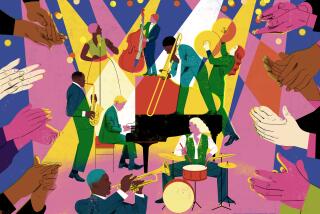JAZZ REVIEW : Roberts Brings Rainbow of Styles to Vine St.
- Share via
Five years ago Marcus Roberts, then 21, joined the Wynton Marsalis group as pianist and composer. Roberts, who was heard last year at Hollywood’s Vine Street Bar & Grill during a leave of absence, has now left Marsalis permanently and is back at Vine Street (through Sunday), leading a unit that is similar to the one he presented previously.
There is one important difference: This is a sextet instead of a quintet, enabling him to bring greater harmonic complexity to his arrangements and to move with ease through a rainbow of stylistic variations.
Roberts is able, within a single set, to move from the starkly basic (his first blues riff tune could have been written and played in the 1950s) to the deeply subtle and spiritual, as in his majestic interpretation of an old Duke Ellington piano solo, “Single Petal of a Rose.”
The musicians he has assembled are young and, for the most part, mature beyond their ages. Roberts is the oldest; the youngest is trumpeter Nicholas Payton, 16, out of school for the summer and already wise in the ways of such long-ago giants as Cootie Williams, whose plunger-muted sound he simulated on one of the less complicated blues pieces.
Payton, who has not developed a distinctive sound on open horn, seemed hesitant at times. The other trumpeter, Scotty Barnhart, has already evolved into a warmly communicative artist, while the tenor saxophonist, Herb Harris III, displays an emotional and technical firmness of purpose rare in such a young man.
What impresses most about these three horn players is that they are not the products of some college band cookie cutter process that churns out hundreds of graduates, too many of whom are long on technique and short on aesthetic development.
The bass player, Chris Thomas, and the drummer, Martin Butler, seem well attuned to the leader’s requirements, such as the constant need to swing and the ability to enrich the overall sound.
Much of Roberts’ repertoire at the show consisted of variations on the 12 bar blues, but each number found a different way to disguise, extend or modify that ancient form, sometimes using a Middle Eastern flavor as in “Nebuchadnezzar,” by changing keys as in “E. Dankworth,” or by the use of tension and release for dynamic and rhythmic contrast.
Roberts’ eclecticism is amazing. On Duke Ellington’s “Black and Tan Fantasy” he began with an almost exact recreation of the composer’s original 1927 piano solo, yet a few minutes later he moved into a florid, lightning pace passage that had 1990 written all over it. The contrast was almost too sharp, like beginning to write an impression of a Hemingway essay and suddenly evolving into James Joyce; but Roberts finally is never dull.
This sextet may take time to develop a full measure of cohesion, but already it provides its brilliant leader with the type of showcase his chameleonic talents require.
More to Read
The biggest entertainment stories
Get our big stories about Hollywood, film, television, music, arts, culture and more right in your inbox as soon as they publish.
You may occasionally receive promotional content from the Los Angeles Times.










